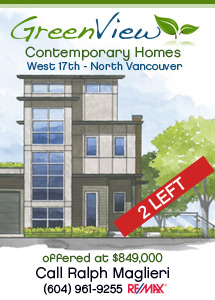Community Vancouver Real Estate Focus: North Vancouver Smart Growth, East Vancouver on The Rise, Kerrisdale Old Traditional Charm & Affordable Housing
North Vancouver Citizens Beware City Smart Growth Agenda
An editorial from the North Shore News newspaper on a citizen’s take on the current Central Lonsdale Planning Study and what it may mean in terms of affordability, livability and the future of the North Shore real estate market. Dear Editor: I wonder how many people will give the City of North Vancouver’s intentions to increase densification on the North Shore real estate the serious review it deserves. Another concern is North Vancouver’s impact on the other North Shore municipalities. Are city residents really being given a choice, or is the process jst steering things towards the outcome that the City of North Van wants? Do the residents of the other municipalities have any say in how the city’s choices affect traffic and crime? It looks like there’s a North Vancouver Smart Growth agenda at work in the city. But looking at the U.S., you see evidence how Smart Growth real estate development has problems. While it seems intuitive that building more housing units within ar egion – thereby increasing supply – should increase affordability, in fact the opposite happens: housing prices go up and traffic problems worsen. More people within an area simply leads to more demand on North Shore housing. The pressure to increase North Vancouver housing density is being caused by policies on land use, agriculture, and transportation that all cause pressure on the supply of land; one can say the shortage of land and the resulting higher housing prices in North Vancouver City are unnecessary.
Looking within Canada, Vancouver has the least affordable housing, some of the worst traffic problems and many advocates of Smart Growth North Vancouver at work. This is fine if you can afford high priced condos in Coal Harbour or False Creek, but if you can’t afford it or can’t tolerate the noise and overcrowding, your only option is the suburbs – especially if you prefer to raise a family. To City of North Van Smart Growth real estate planners, your own backyard isn’t even counted as livable green space. Instead you should hope to have a nice view of the greenbelt from your condo and play only in designated public spaces. Taken to this extreme, the most prized outome of Smart Growth in North Vancouver real estate surely must be found in the over crowded cities of Japan, where people’s apartments are scarcely more than bedrooms and where they spend most of their time shopping or in the entertainment districts. Sprawl has been described as something that always happens in somebody else’s neighbourhood, but never your own. This explains some of the unspoken snobbishness of Smart Growth. Smart Growth real estate development plans appeals to people (in terms of) environmental responsibility, and that is valid. But there are difficulties around sustainable growth and what that term really means. Without an open discussion of some of the assumptions and choices underlying Smart Growth in North Vancouver City real estate, people will probably not get what they assume they are getting (when they agree to it).
Randy O’Toole, senior fellow with the Cato Institute and author of The Vanishing Automobile and Other Urban Myths: How Smart Growth Harms American Cities, wrote about Metro Vancouver’s Livable Region (strategy): “To avoid sprawl, (Metro Vancouver) closed more than 70 per cent of the region’s land to real estate development and mandated that all cities in the region accommodate growth by increasing population densities. The result has been skyrocketing housing prices and, for most families, an end to the great Canadian dream of owning your own single family home.” On the North Shore, it’s easy to see that traffic is bad enough on the freeways and bridges, but speaking for myself, it’s tolerable most of the time. I find the North Shore a very liveable place to live and to work. Now we have the City of North Vancouver Smart Growth development Plan trying to cram more people on to the North Shore, and it’s hard to see how this will benefit traffic and make the region more livable. Isn’t it more sustainable not to increase the population? Or limit growth to a smaller scale approaches such as secondary rental suites and coach houses? The North Shore may already be at capacity in many ways, so I would argue for a moratorium against increasing densification for the foreseeable future. If Metro Vancouver ever pays any real attention to the transportation challenges on the North Shore, then perhaps it can be considered at that time. J. Morrison of North Vancouver (information technology consultant who lived in the District of North Vancouver since 2003).
East Vancouver real estate becoming increasingly popular
According to Metro Magazine contributor Andrea, more people in East Vancouver are swapping rent for mortgages and purchasing property in this district more than ever before. As housing in Vancouver goes up in price and down in availability, a number of trends are appearing, according to Peter Simpson, the CEO of the Greater Vancouver Home Builders’ Association. One is that more and more people in East Vancouver are swapping their monthly rent for mortgage payments. “some folks who buy homes will find that their mortgage payments are consistent with what they used to pay in rent,” said Simpson. “So now they’re paying themselves and not a landlord.” Another is the manifestation of what Simpson calls “mingles.” “These are single people who are not related to each other, who are not in a relationship with each other and want to become roommates, but this time in a purchase situation,” he said, adding that “mingles” in East Vancouver real estate are usually women. “They’re pooling their resources and… now they own a place and are building their home equity.” A third trend in East Vancouver’s property market is that more people are opting for multi-family housing. “For a first-time homebuyer, a decade ago, their first choice was a single-family home like mom and dad’s,” said Simpson. “Today there are more realistic expectations; they have condos, townhouses that they know will likely be their first home.” Simpson said while no one municipality is particularly more affordable than any other, there are certain areas that are becoming increasingly popular for young homeowners. East Vancouver is one because of the recent real estate condo development. The Tri-Cities area and Surrey Town Centre are also popular because the rapid transit lines run through them, he said.
Kerrisdale Vancouver – Destination Neighbourhood
Centred along the unbashedly eclectic retail strip spanning 41st Avenue between Arbutus and Balsm, Kerrisdale Vancouver is a neighbourhood with upscale charm, a fun loving charm and a distinctly creative leaning. Community Snapshot by 24 Hours newspaper. Folks here like to mingle, so there are plenty of well frequented gathering spots often decoarted with displays of local artwoork for sale in addition to food and drinks. One retired city planner, frequently seen sipping lattes and chatting with passer by at Bean Bros. Coffee, Postulateds kerrisdale real estate attracts more people as a destination neighbourhood to visit for an afternoon than any other in the Lower Mainland. Like its residents, Kerrisdale real estate housing is a mix of young and old all coexisting with an easy going camaraderie. But don’t expect Kerrisdale housing to be cheap. Houses in Kerrisdale real estate start near the $1 million mark for what some lovingly refer to as an “old timer in need of some TLC,” but would more accurately be described as a tear down with land value only. For an extra $300,000, you can find Kerrisdale homes with cosmetic renovations but still the boxy, segmented interiors that characterized houses from the 1940s and 1950s. If you’re looking for the graciousness typically associated with Kerrisdale real estate, expect to pay a minimum of $1.7 million, and most likely $2 million or more. But in this price range, you can expect a lot – elegant architecture, large lots, open floor plans, often even feng shui design elements. Tough to find, older kerrisdale townhouses in Vancouver start at $600,000 and in short order race past the $1 mllion mark finally settling near $1.5 million for a brand new unit in the Kerry Kerrisdale property development. Currently well under construction in the 2200 block of West 39th Avenue, the Kerry Kerrisdale is also where you’ll find some of this neighbourhood’s most expensive apartment homes – each one spanning a single floor for true 360 degree outlooks and commanding prices averaging $2.5 million. There are however some bargains to be had in the Kerrisdale apartment market. Older buildings with generous floor plans, but not necessarily the floor to ceiling windows, gas fireplaces, or in suite laundry de rigueur in new products, are available for well under $400,000 – though you’ll have to watch closely as a surprisingly high proportion of these are co-op Kerrisdale buildings, that require higher down payment and are less appealing to financial institutions. For $600,000 and up, there’s usually a selection of concrete Kerrisdale condo suites, often in mid-rise or highrise condominium towers offering amenities like air conditioning, top-end appliances, and onsite recreational facilities. Currently, Kerrisdale real estate’s two most expensive properties are an 11,000 square foot mansion with eight bedrooms and gold plated light fixtures on offer for $6.7 million and a 2,400 square foot penthouse condominium in 5955 Balsam Kerrisdale real estate boasting two bedrooms, two levels, a 2,300 square foot patio and a price tag of $3.9 million. Written by S. M. Boyce for 24 Hours.
College Project Developers Affordable Housing for Vancouver
On another note in 24 Hours newspaper, Matt writes about the possibility of more affordable ways of constructing housing in the Lower Mainland to offset the rising costs of home ownership and lack of affordable housing for the homeless. Affordable housing can be created, just ask a group of design students who have spend the last 17 weeks building some. While the four display units now sitting outside UBC’s forestry building aren’t a magical solution to the city’s social issues, Emily Carr industrial design instructor Christian Blyt says it’s a start. “We finally have something to show people,” Blyt said, as 15 of his innovations in Wood Design students – and two UBC forestry students – put the finshing touches on four pre-fabricated transitional housing units. “Hopefully, we’re setting up a dialogue on how it can be done. We can do something, but it has to start somewhere.” His students believe that starting point lies within their real estate project. “We did a lot of research on homelessness and what it’s like to be homeless, so we know what people need,” said student Tina Lu. “These units are pretty simple but it suits people in transition.” And on a $1,500 budget, the students believe the ready-to-assemble homes could serve as a model for quick and easy housing Vancouver real estate projects.
Labels: Vancouver Housing Market, Vancouver Neighbourhoods, Vancouver Real Estate Stats







0 Comments:
Post a Comment
<< Home